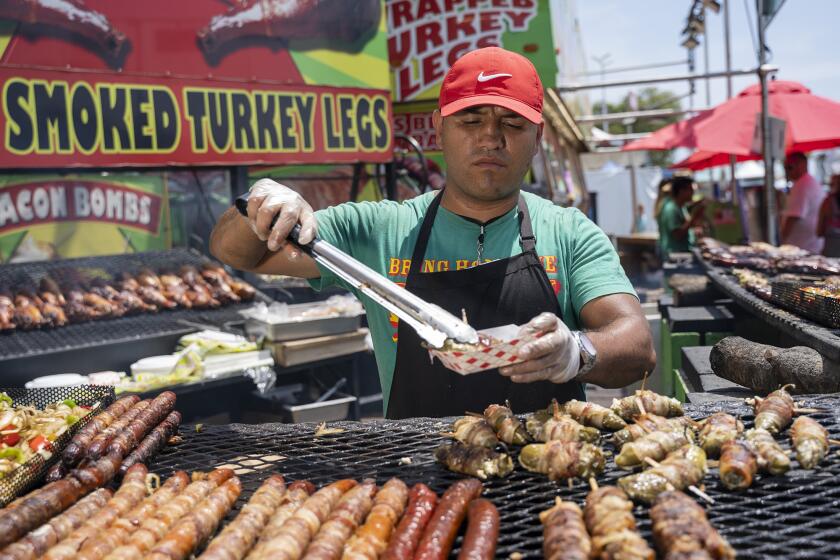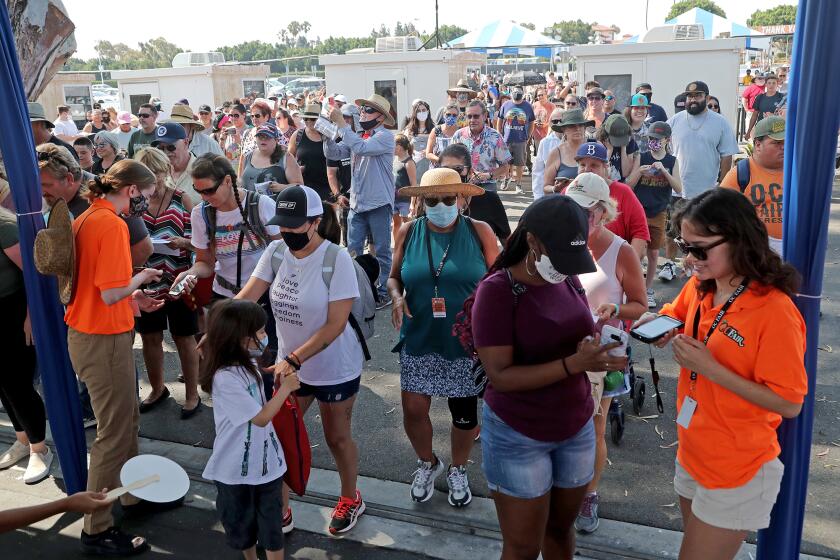No hogwash here! All-Alaskan pigs fly at O.C. fairgrounds

- Share via
To a chorus of squeals and cheers from the surrounding stands, little pigs hoof it around a bound racetrack late Friday afternoon in search of victory. A few of them, well, just settle for eating some of the grass they pass along the way.
Some pigs are just hungrier for glory.
Or, hungrier for an extra portion anyway.
Waylen Herdman, an announcer and pig handler for the All-Alaskan Racing Pigs attraction at the Orange County Fair, said that the smarter the pigs are, the faster they realize that winning a race — or several races, depending on the luck of the hog — means that they usually get a little extra food or a treat. The laggers get another kind of attention.
Plenty of fried foods and other favorites are available in fun-size portions each Thursday.
Herdman’s fellow hog wrangler, Randy Garfield, joked that the least motivated pigs tend to be the ones that are the crowd favorites.
“They trot around this track. They do crazy stuff. They’ll run out of the gate into the crowd, find their way back in, eat grass on the way, so. It’s really in the eyes of the beholder,” said Garfield.
“People still love Strawberry, even though she’s our model and she comes in last place,” he said, laughing. “She just doesn’t have any motivation to try anymore after she got this gig.”
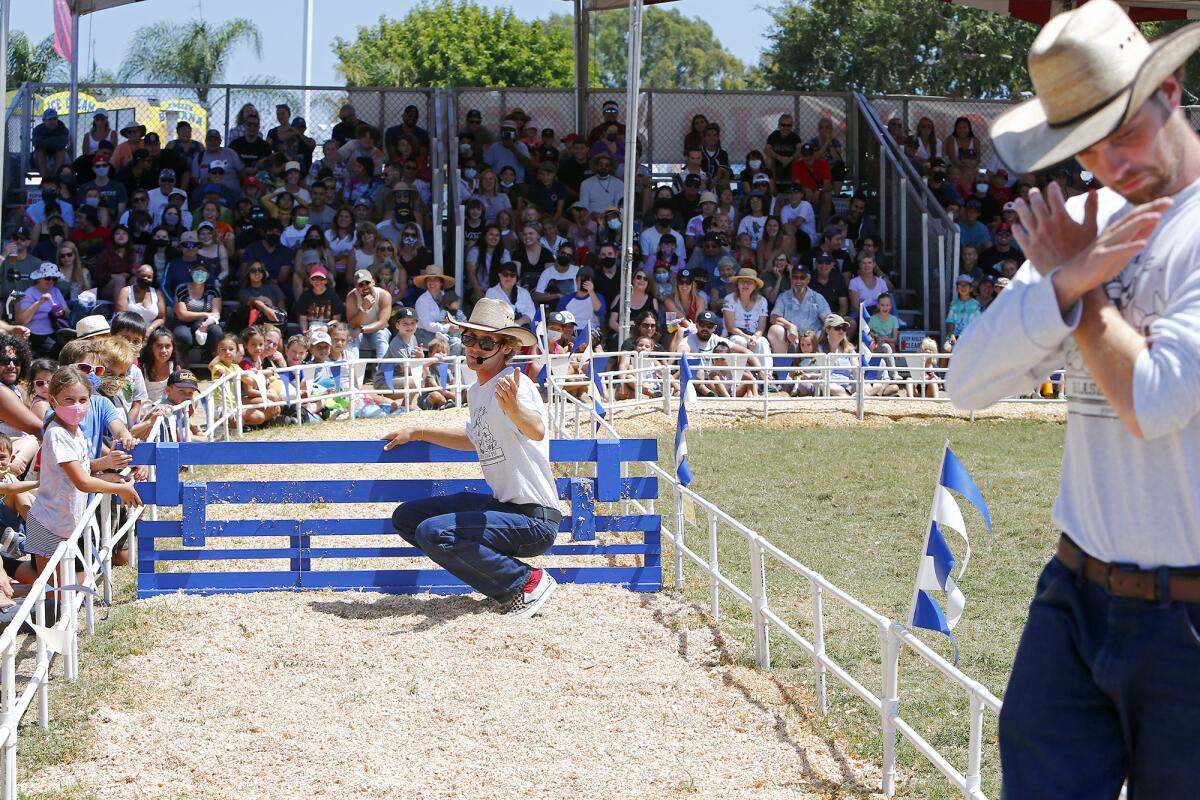
The All-Alaskan Racing Pigs are a fixture at the Orange County fairgrounds — located not far from the Pacific Ampitheater — and owner Bart Noll estimates that they’ve been part of the fair for at least 25 years, if not more. But the show itself dates back to 1987, when Noll and his wife, Deanne, decided to hold a one-off pig race back when they lived in Fairbanks, Alaska.
“We were going to do it once, have some fun and we had fun, but, the one-off thing,” Noll said, laughing. “It didn’t turn out that way. That’s where [All-Alaskan Racing Pigs] comes from. We are the Alaskans, but the pigs are not the Alaskans.”
Friday morning found residents, and organizers of the O.C. Fair, chomping at the bit to resume a beloved local tradition the pandemic had put on pause.
Noll learned about packaged pig races through a trade magazine on fairs when he was an assistant fair manager.
“All I needed to hear were ‘pigs’ and ‘races’ put together and the vision of the show took place in my head. My wife and I talked it over. ‘This is what it should look like’ and what [people] see now is roughly what we came up with,” said Noll. “It’s designed to be a fun attraction and an educational attraction.”
Noll said they did use Alaskan pigs early on, but that it eventually became difficult to do so after the family eventually took the operation to the West Coast. All-Alaskan Racing Pigs are headquartered in Eugene, Ore. where Noll gets his races from a breeder of Gloucestershire Old Spots, an English breed of pig that gets its names from the patterning of its coat.
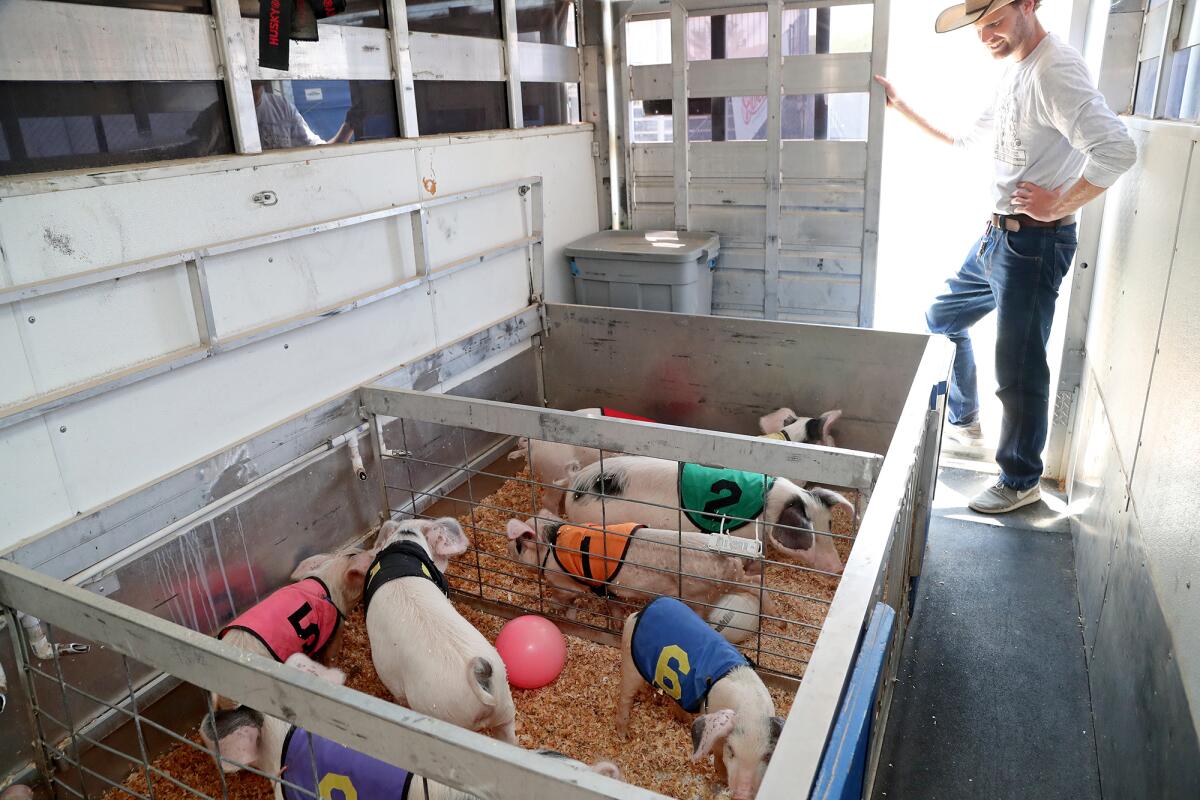
According to the Livestock Conservancy, a nonprofit organization that focuses on the preservation and promotion of rare, heritage breeds of livestock, Gloucester Old Spots were imported to the United States sometime in the 1900s but never became populous and were practically extinct by the 1990s until new piglets were imported to the country in 1995 and a breed society was founded.
Noll said the All-Alaskan Racing Pigs work in tandem with the organization and, while traveling up and down the West Coast, they educate people on the pigs and eventually disperse them to small and large farmers when the pigs age out of racing because of their size after about 2 ½ to 4 months.
“We kind of fell into all of this accidentally,” said Noll. “Once we started working with the breed, our role in [conservation] became apparent right away. I enjoy doing it. I think it’s an important mission that is being carried out here and we’re proud that we’re able to help in the effort and facilitate distribution.”
The pigs start racing after about five weeks of birth, once they’ve been weaned off their mothers. Garfield said it takes patience and a little bit of athleticism to train a pig to race, but Herdman added that the swine are definitely food-motivated animals.
They initially train on a little track in Eugene before teams are taken on the road, where they then often have to relearn how to race because of new environments.
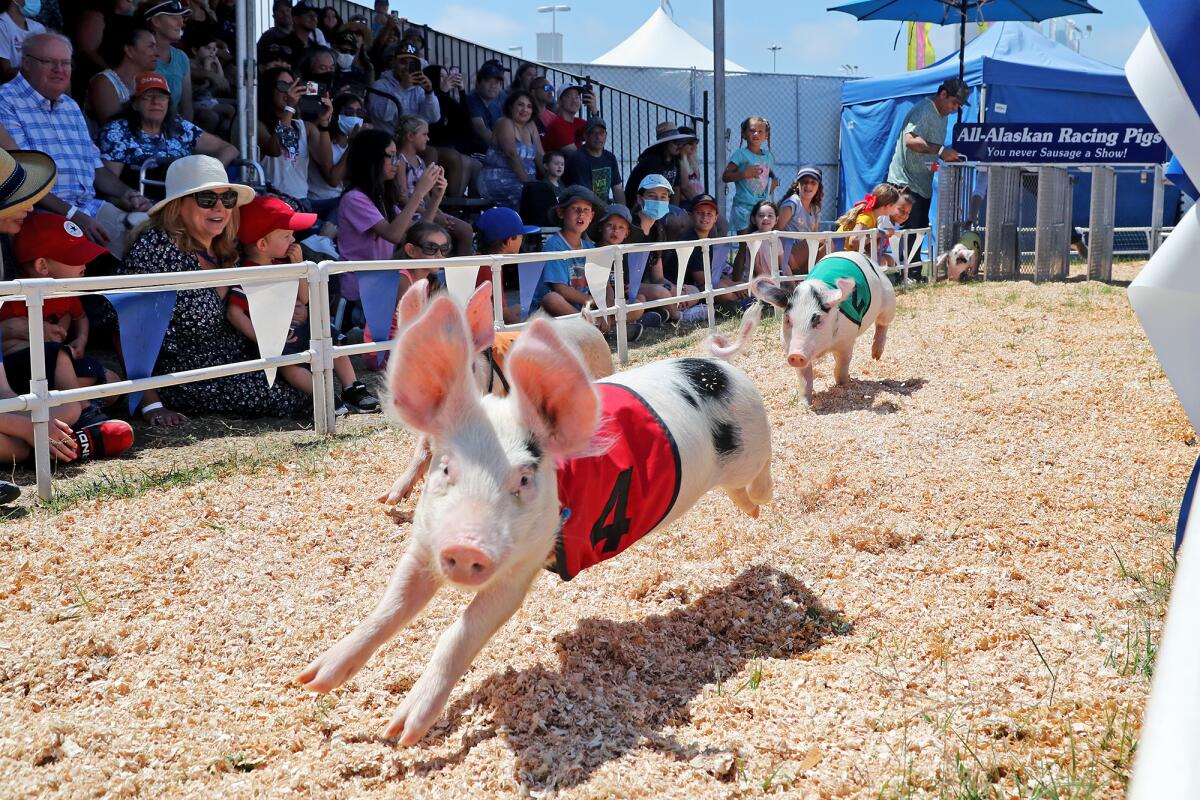
The pigs at the fair all have names, but Garfield and Herdman say that the names are sometimes interchangeable depending on the day and depending on which pigs race. They currently have 12 at the Orange County Fair, but only run about eight a day and switch out the swine every so often as necessary.
Their most common names are Sophie Smith, Strawberry, Sourdough Jack and Bob. Herdman’s partial to naming pigs Miss Piggy, while Garfield offered celebrity pig puns like Hamela Anderson, Smellin’ DeGeneres and Oinkle Phelps.
The two share the role of announcer and pig wrangler, even keeping a notebook full of pig puns on hand in their trailer.
Garfield and Herdman came into the racing pig business by pure chance, both having applied online through a general job listing.
“I didn’t know pig racing existed before I got this job,” said Garfield. “But the description online was too good to scroll past without looking into it. Pretty much, one thing led to another. They narrowed down the pool of applicants and it seems like we are the type of people who would be good at this job.
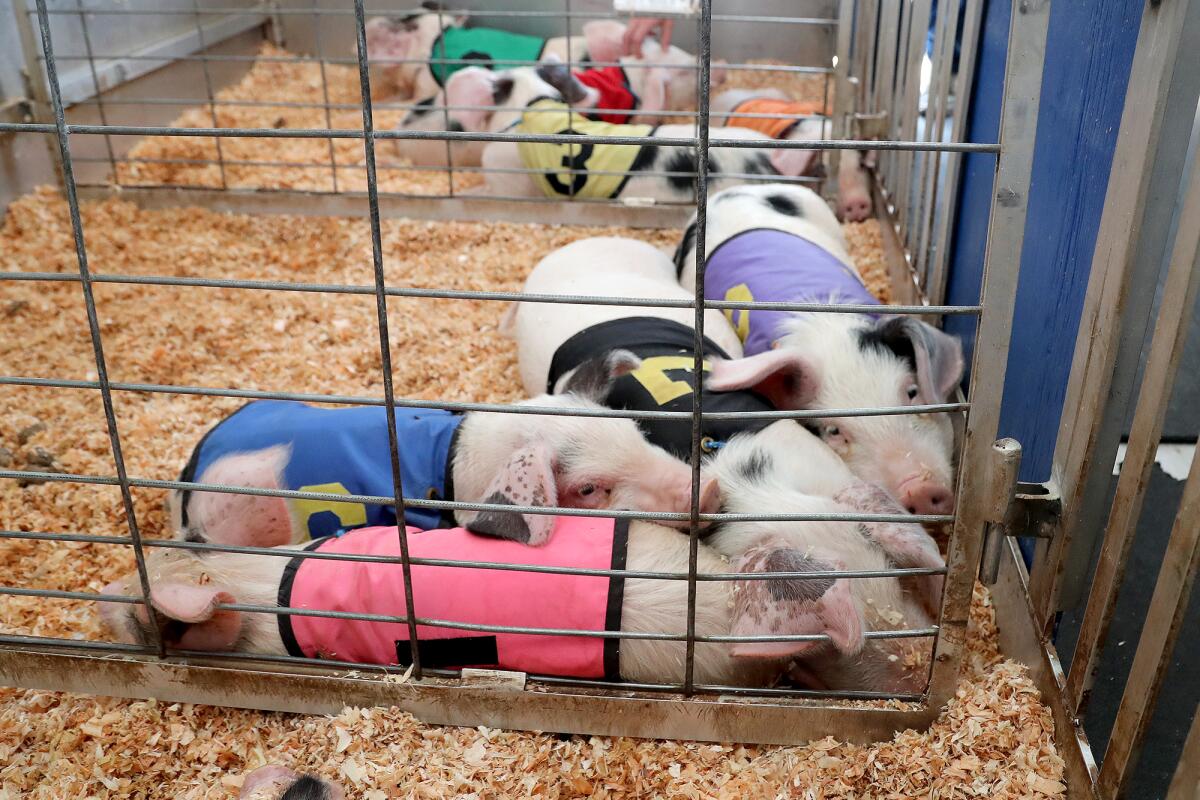
“I don’t know what that says about us, but here we are.”
Their days begin at 9 a.m. The two work to clean up the track and the pigs — arguably cleaner than pigs might like, but they do it, they joke. Once that’s done, they go off about their business until about half an hour before showtime when they dress the pigs and hype them up.
Then, there’s the retail side of the operation, where fair goers can buy related T-shirts, stuffed animals and other items. The team, which also includes Bart Noll’s brother Sam, have a host of duties, ringing up sales and helping visitors take photos with the pigs.
After their five or six shows a day, they come back to the air-conditioned trailer where the pigs are housed, remove the dividers in the pen for the pigs to roam and then go to bed themselves.
“That’s our day. It’s all pigs,” said Herdman.
“The fulfillment in doing a show, especially when a show goes really well, is very rewarding. Absolutely. But as this job goes, ... the reality of doing the show is it’s a very fun and adventurous job, but we’re transient, living in an RV,” said Garfield. “It’s fun, but we’ll see. It’s certainly a young man’s game, I’d say.
“But sometimes, I think about the other jobs I could be doing and I’m glad I have this one,” he added.
All the latest on Orange County from Orange County.
Get our free TimesOC newsletter.
You may occasionally receive promotional content from the Daily Pilot.
